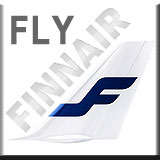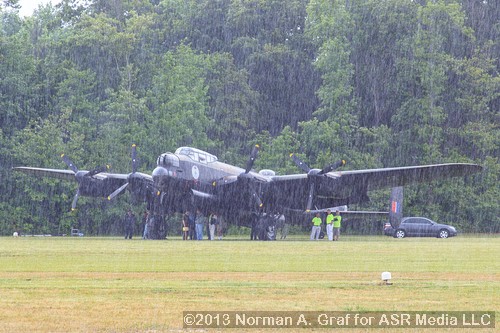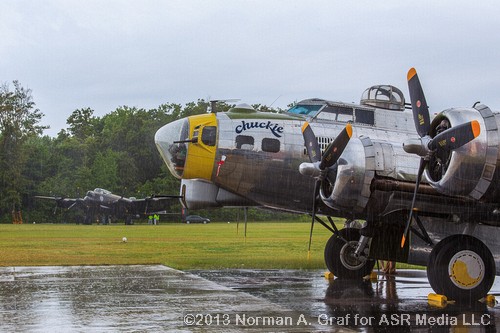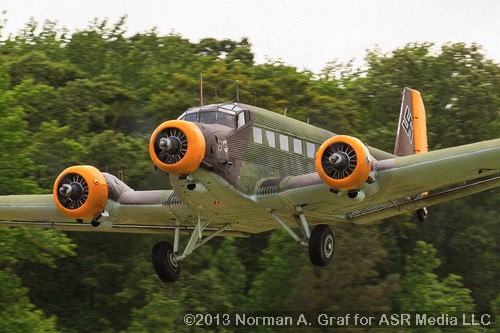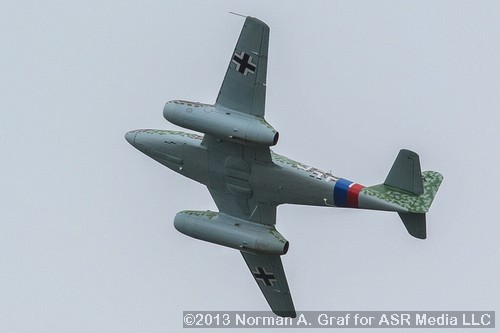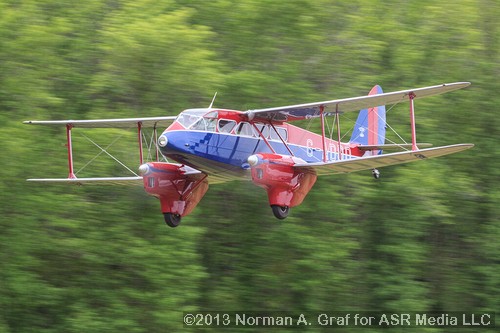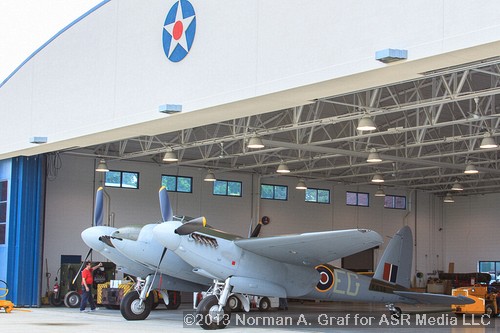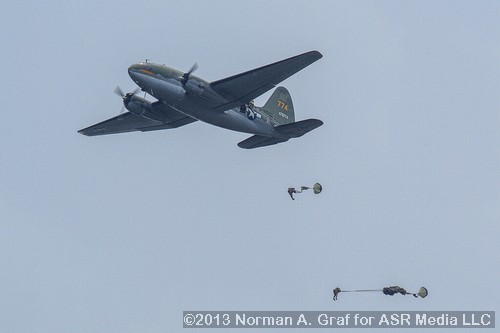|
|
|
The Military Aviation Museum held its fifth annual “Warbirds Over the Beach” Air Show May 18-19. The air show primarily showcases the museum’s own collection, but always includes some notable visitors. The museum continues to grow at an amazing pace, adding both aircraft and new buildings to house them. The star of this year’s event was to be the recently completed de Havilland DH-98 Mosquito performing in its inaugural air show. It is the only flying Mosquito in the world today, and its return to flight has been eagerly anticipated. The Canadian Warplane Heritage in Hamilton, Ontario, Canada sent down an Avro Lancaster and C-47 Dakota, so expectations were high to see an RAF flyby composed of the Lancaster, Mosquito, Spitfire and Hurricane. Unfortunately, spring weather on the East Coast is a force to be reckoned with, and this year’s show was hard hit by heavy rains. A handful of trainers and lighter aircraft flew Saturday, but a heavy thunderstorm limited the flying on Sunday to a single aircraft. |
| One of the appeals of this air show is that the aircraft take off and land from the grass airstrip adjacent to the museum. This brings the action close to the viewing lines, and makes for some very photogenic departures and arrivals, especially for the older warbirds. However, the ground is very susceptible to poor weather conditions, especially rain. Roughly an inch and a half of rain fell on Friday night and into early Saturday morning, thoroughly soaking the ground. Nevertheless, visitors showed up promptly at 0900 and were very efficiently guided to parking areas right across the street from the museum. Most of the museum’s aircraft were arrayed along the runway on static display. As the rain stopped and the weather cleared, tarps were removed and other aircraft were rolled out of the hangars. The aircraft are not roped off, giving very good access both for viewing and photography. In addition to the static displays, booths set up in the empty hangars, a very large military re-enactors camp, plus aircraft in the WWI Hangar provided plenty to see and do. Many of the earliest visitors made a beeline to the Fighter Factory hangar, where the Mosquito was being prepped for flight. The aircraft is immaculately restored and it was a treat to be able to view the aircraft from all angles, take a peek into the cockpit, and look at the exposed Merlin engines as final tune-ups took place. The only restriction was “Don’t touch!” Next to the facility is the recently restored Luftwaffe hangar. Built in 1934 in Cottbus, Germany, the hangar was used throughout the Second World War by the Focke-Wulf Company for, among other things, manufacturing the Fw 190 aircraft. Hangar 6 now houses the museum’s German WWII aircraft. Tucked into a corner was a Fw190 D-9 aircraft, soon to be returned to flight. |
| The flying was scheduled to begin at 1300 and by then the runway and access had dried out enough for some of the trainers and lighter aircraft to take off. In addition to the Stearman, SNJs, PT-19 and PT-22, rarities such as a DH-89 Dragon Rapide, Fieseler Storch and Fw44 Stieglitz took to the air and made a number of passes over the treeline to the south of the museum. The only fighter to take off was an FM-2 Wildcat, splashing through puddles of water as it made its way to the runway. The Messerschmitt Me262, based out of Suffolk Executive Airport, made an appearance in the sky and made several passes in the air show box to the west of the museum. The final aircraft to fly was the Junkers Ju52, which made several passes, banking hard to show off its upper side to the crowd. After the close of the air show flight restrictions the Avro Lancaster and C-47 Dakota took advantage of the drier runway conditions to transfer to the paved runways of nearby Norfolk Airport. The Lancaster made several passes before departing. |
Sunday morning brought clearer skies and a light breeze. Hopes were high that all the aircraft, especially the Mosquito, would be able to fly. Shortly before 1300 the C-46 Commando took off to open the show with a paratrooper drop. By then the skies had already started to darken, with storm clouds rapidly approaching. After circling several times to gauge the wind conditions, the Commando dropped its first group of parachutists, followed shortly thereafter by the remaining troops. At this point Lightning and Thunderbolts (not P-38s and P-47s!) made an unscheduled appearance, causing the visitors in the metal bleachers to quickly leave and scramble for shelter as the rain started. The downpour was fairly brief but intense, and the additional half inch of rain once again soaked the ground and brought all remaining flying to an end. Once again “the schedule is subject to change due to weather.” However, that was not quite the end of the day’s excitement. Rescue vehicles crossed the field to the treeline on the opposite side and an array of increasingly larger hook and ladder fire trucks soon followed. Three of the paratrooper re-enactors had made tree landings. One lowered himself 30 feet with a slack line he carried, one was brought down 33 feet by a ladder truck and the final one was rescued by a tactical team since vehicles could not reach him. There were no injuries. As the rain continued, visitors made their way to their cars and left. |
| An estimated 6000 people visited during the weekend, and the museum graciously issued rain checks to those on Saturday to attend Sunday’s show. Additionally, tickets were valid for museum admission the following week. |
I’d like to thank Chris Vtipil for coordinating the media access and providing assistance during the air show. This air show, with so many rare or unique aircraft based at the museum, plus the high quality of the visiting performers, has enormous potential for becoming a “must-see” warbird show. And if you can’t make it during the air show, the museum itself is worth the trip. Here’s hoping for better weather next year. |
Aircraft which flew on Saturday included:
|
- AT-6 /SNJ Texans
- Avro Lancaster
- C-46 Commando “The Tinker Belle”
- C-47 Dakota
- de Havilland DH-89 Dragon Rapide
- Fairchild PT-19
- Fieseler Fi-156 Storch
- FM-2 Wildcat
- Focke Wolfe FW-44J Stieglitz
- Junkers Ju52
- Messerschmitt Me262
- Ryan PT-22 Recruit
- Stearman
|
Notable warbirds on static display included:
|
- de Havilland DH-98 Mosquito
- AD-4 Skyraider
- B-17G Flying Fortress “Chuckie”
- B-25J Mitchell “Wild Cargo”
- DH-82A Tiger Moth
- FG-1D Corsair
- Focke Wulf Fw-190 A-8
- Focke Wulf Fw-190 D-9
- Hawker Fury
- Hawker Hurricane
- P-26 Peashooter
- P-40E Kittyhawk
- P-51D Mustang “Double Trouble two”
- PBY-5A Catalina
- Polikarpov I-15bis
- Polikarpov I-153 Chaika
- Polikarpov Po-2
- SB2C Helldiver
- Spitfire Mk IX
- TBM-3E Avenger
- Yak-3M
|
Rating: 8 out of 10 (due to the weather) |
|
|
|
|
|
|
| |
|
|
 |
